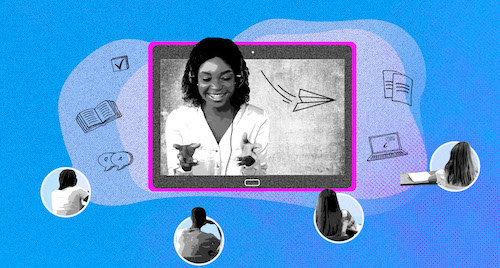
Browse the headlines about how the remote K-12 school year is going and you’d probably think things have gotten off to a pretty catastrophic start. CEHHS Associate Dean and Professor of Educational Technology Stein Brunvand says there’s certainly reason for a gloomy assessment. Students learning from home poses huge logistical challenges for parents working remotely and in-person alike. Many families have multiple students trying to learn from the same home, or even the same room. Under-resourced schools still have fewer resources, and we’re getting a new look at how deep the digital divide really runs. On top of that, school boards, administrators and teachers are now having to split time between their core work and crafting complicated learning plans — which are often quickly undermined by the shifting nature of the pandemic.
But Brunvand says it’s important to disentangle these kinds of systemic or logistical challenges from what’s going on in actual classrooms. There, he says, there’s actually a lot of interesting, innovative things happening — in large part because teachers have poured a ton of time into figuring out how to make a digital classroom work. Brunvand has lent his own expertise as an educational technology specialist to that cause. Back in the summer, with funding from the Jean and Ken Simpson Professional Development Series for Educators, he led a free workshop for 33 area teachers and held a follow-up in September, which drew 14 more. The goal was to quickly train-up teachers in digital classroom best practices and useful software tools so they could not just get through the school year, but have a good one.
Cynthia Tumas, who teaches 8th grade English in Taylor, attended both workshops, and she’s since boldly ventured into implementing the core idea from Brunvand’s second mini course: the “flipped” classroom. As the name suggests, a flipped class is sort of the inverse of a traditional one: Typical homework activities are done as a group in class, while some of the traditional teaching content is shifted to the home environment. In her English class, that means they spend a lot of their synchronous on-screen time together reading and discussing the text of the week. Then, on their own time, students do activities that dive more deeply into background and analysis — things Tumas typically handled during her in-class teaching.
Tumas says this nontraditional model has already revealed some key benefits. Most notably, by making reading a classroom group activity, more kids are actually doing it. And the new “flipped” homework is going well too, in part because she’s getting creative with the assignments. “For example, we just read a story called ‘Rogue Wave,’ which is based on a true story of a 16-year-old girl who attempted to sail around the world,” Tumas explains. “And before we even read the story, for homework, I had them read an article about Baha, California, where Abby [Sunderland] is from; and then I found a TED Talk of Abby talking about the experience. I honestly didn’t know if they’d do it, but when they came to class, it was clear from the discussion that they had done the work. Plus, having learned about Abby beforehand, they were really excited to read the actual story.”
Tumas is also incorporating several of the software tools she learned about in Brunvand’s class. She uses the game-based Quizlet flash card app to check for comprehension. And she has her students submit answers to prompts or short essay questions using Google Forms. Next up, she really wants to launch an online discussion forum where the kids can chat about relevant topics among themselves, using text, emoji, links, videos — whatever they find useful.
Brunvand says he’s encouraged to hear of Tumas’ successes. “It's amazing, really. She’s gone whole hog on this,” Brunvand says. “And what’s especially great is that English is not the first subject area I’d think of for a flipped classroom. So the fact that she’s making it work is encouraging for all kinds of teachers.”
In fact, both Brunvand and Tumas say they’d like to see some of these ideas stick around after the pandemic. Tumas, for one, enjoys teaching online so much she says she’d happily continue in that format. And even if the post-pandemic world doesn’t usher in such broad reforms, Brunvand says he expects many teachers will be looking to bring their new expertise back to their face-to-face classrooms.
“I think even if we go back to 100 percent face-to-face, there will be a lot of interest in using these online classroom environments as part of the educational experience,” Brunvand says. “Maybe that means using them to turn in more assignments, rather than just doing hard copy assignments; or having students discuss topics with each other in online forums rather than just writing essays on their own. Put it this way: For a lot of teachers, I think there was nothing more terrifying than having to lead their first Zoom class. Now that we can do that, we should come away feeling like we can do anything."




